 Lizzie Grayshon, GWCT Wetlands research assistant
Lizzie Grayshon, GWCT Wetlands research assistant
The Avon Valley
The River Avon develops into a large calcareous lowland river south of Salisbury, which is of national and international importance for its wildlife communities. The floodplain consists of humid, species-rich grassland, with ditches and some standing water usually persisting through the spring months. The floodplain SPA and SSSI designations reflect its value for a wide range of species, including breeding waders, wintering wildfowl and waders, otters and certain insects, molluscs and plants of national importance.
The traditional farming pattern of the valley reflects the propensity for winter flooding, with relatively low-intensity livestock farms and a predominance of grazed pastures and hay fields. The numbers of breeding waders in the Avon Valley have declined dramatically, with declines of 64% in lapwing, 75% in redshank and 97% in snipe during 1982-2002. Similar declines have been seen across many other lowland wet grassland sites throughout Britain. Declines have also been seen within aquatic communities and for species including salmon, roach, perch and eel.
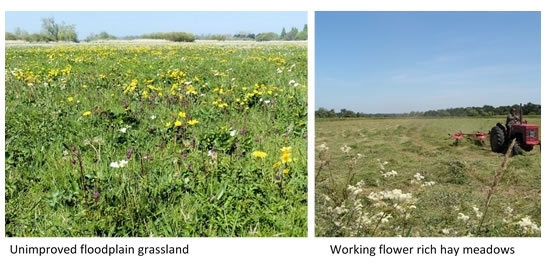
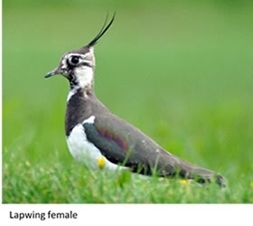 The GWCT has been working in the valley for 20 years, undertaking surveys, raising awareness of issues and working with landowners to initiate change. We host regular meetings with farmers and landowners at least once a year and, having built trust, we have started to initiate habitat restoration projects through the LIFE Waders for Real project and the Ellingham Floodplain Restoration project.
The GWCT has been working in the valley for 20 years, undertaking surveys, raising awareness of issues and working with landowners to initiate change. We host regular meetings with farmers and landowners at least once a year and, having built trust, we have started to initiate habitat restoration projects through the LIFE Waders for Real project and the Ellingham Floodplain Restoration project.
The Project
The project is focused on the Ellingham water meadows, located just above Ringwood. These meadows consist of species-rich wet grassland and rush-pasture supporting a wide-range of characteristic lowland floodplain species, including breeding waders, wintering wildfowl, otter and water vole.
The Ellingham Floodplain Restoration project is a holistic project that encompasses multiple species benefits. The project is managed by the Game & Wildlife Conservation Trust based in Fordingbridge in partnership with Somerley Estate, graziers and tenants, with funding from Tarmac Landfill Communities Fund. The project is running alongside and building on work by the Waders for Real project already running in the Avon Valley, which aims to reverse the decline in breeding lapwing and redshank, by the creation of hotspot sites with ideal habitat and management.
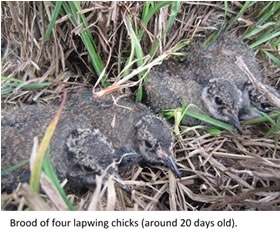 As the breeding waders are priority species in the valley, we aim to further enhance habitat in and around the favoured nesting fields by creating six scrapes to hold water into spring and through selective pollarding of trees and scrub removal to open-up the landscape. The management of these fields should also make them more attractive to snipe, teal and wigeon in winter. A relict oxbow has been reinstated which lies 800m from a Tarmac aggregates site, to benefit fish, particularly roach, and aquatic invertebrates.
As the breeding waders are priority species in the valley, we aim to further enhance habitat in and around the favoured nesting fields by creating six scrapes to hold water into spring and through selective pollarding of trees and scrub removal to open-up the landscape. The management of these fields should also make them more attractive to snipe, teal and wigeon in winter. A relict oxbow has been reinstated which lies 800m from a Tarmac aggregates site, to benefit fish, particularly roach, and aquatic invertebrates.
Habitat Restoration
The Ellingham Floodplain Restoration project is one of the largest habitat restoration projects running in the valley. This autumn, some 400m of oxbow has been reinstated, 6000m² of fen habitat has been created, four scrapes have been added and several stretches of willow and alder have been pollarded along ditch lines.
 Ellingham water meadows, before (left) and after (right) reinstating the oxbow lake.
Ellingham water meadows, before (left) and after (right) reinstating the oxbow lake.
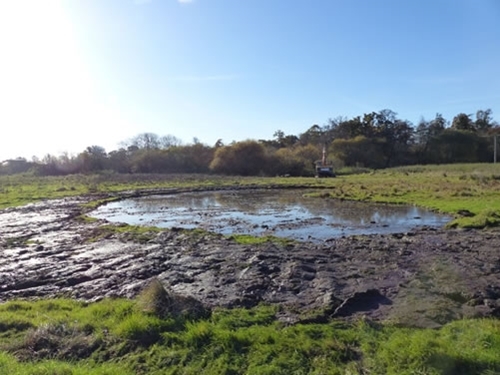
A new scrape for breeding waders
Outcomes
Excavation of the oxbow is intended to provide a sanctuary area for fish, in particular roach, which are in serious decline in the middle reaches of the Avon, by affording a spawning site and somewhere to avoid washing out during peak winter river flows.
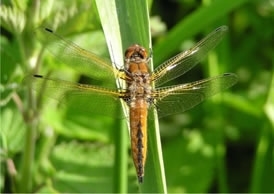 Scarce chaser – listed under category 3 (scarce) in the British Red Data Book on Insects, inhabits areas with good water quality which supports submerged and floating plants.
Scarce chaser – listed under category 3 (scarce) in the British Red Data Book on Insects, inhabits areas with good water quality which supports submerged and floating plants.
The open banksides and resulting vegetation community, closer to fen than the current woodland, should afford more habitat for otter, water vole and water rail, all of which breed within two miles of the site, as well as nesting sites for gadwall. Small areas of willow will be left as habitat for Cetti’s warbler and sedge warbler.
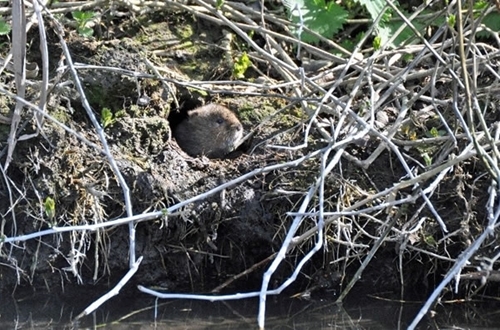 Water vole
Water vole